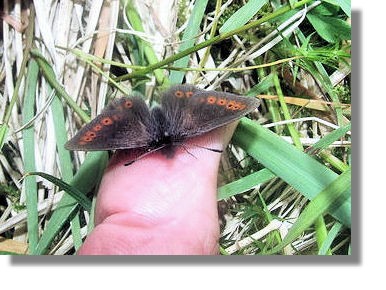
Graphic via Stan Campbell Wikimedia
Butterflies of Scotland
- Mountain Ringlet (Erebia epiphron)

The Mountain Ringlet is the only true mountain species found in the UK. It is rarely observed as it is confined to the English Lake District as well as in some of the mountains of Argyll above 350 metres (1150 feet) such as Ben Lawers, Lochan an Eireannaich, Glen Dochart, Strathfillan (Ben Lui, Cam Chreag, Beinn Chaorach and Meall Buidhe), and Ben Lomond. Also on Schiehallion in central Perthshire in the east with two known colonies further east in the Cairngorms National Park - Glen Doll & Glen Feshie. It also occurs in the Loch Lomond and Breadalbane areas where suitable habitat of mountain grassland occurs.
This dark brown butterfly has a wingspan of just 38mm (1.5 inches)and has a row of black-centred orange eyespots, of varying number, on the wings, similar to the Scotch Argus, (which has white dots in the eyespots, however). Another distinguishing feature is the white legs and white antennae. Adults are highly active only in bright sunshine but can be disturbed from the ground even in quite dull weather. They keep low to the ground in short flights, pausing regularly to bask amongst grass tussocks or feed on the yellow flowers of Tormentil. The main foodplant is believed to be Mat-grass (Nardus stricta). In Scotland, the butterfly favours south facing slopes.
In Scotland the Mountain Ringlet occurs between 350-900m from sea level and prefers south facing slopes, flying from late June to early August, living for just 20 days. The caterpillar feeds on the tips of grass at night and hides at the base of the grass during the day. It hibernates in late August through the winter and emerges to feed again in the spring before pupating in late May or June, emerging again to feed in the spring. Its origins go back to the last Ice Age, 10,000 years ago. Its range appears stable, although there is evidence that due to global warming the species is emerging earlier in the year and may also be migrating to higher parts of its mountain home - which could cause problems once the top of a mountain is reached!
Return to the Butterfly Index
or go to the next Butterfly:  Northern Brown Argus.
Northern Brown Argus.
Where else would you like to go in Scotland?

